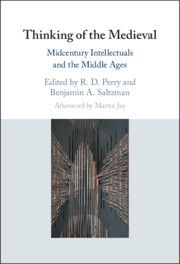Book contents
- Thinking of the Medieval
- Thinking of the Medieval
- Copyright page
- Dedication
- Contents
- Contributors
- Acknowledgments
- About the Cover
- Introduction
- Part I Politics
- Part II Arts
- Chapter 5 Curtius and Jung
- Chapter 6 Old English at the Midcentury
- Chapter 7 Erwin Panofsky’s Neo-Kantian Humanism and the Purported Relation between Gothic Architecture and Scholasticism
- Chapter 8 “Are Women Human?”
- Part III Epochs
- Bibliography
- Index
Chapter 7 - Erwin Panofsky’s Neo-Kantian Humanism and the Purported Relation between Gothic Architecture and Scholasticism
from Part II - Arts
Published online by Cambridge University Press: 07 October 2022
- Thinking of the Medieval
- Thinking of the Medieval
- Copyright page
- Dedication
- Contents
- Contributors
- Acknowledgments
- About the Cover
- Introduction
- Part I Politics
- Part II Arts
- Chapter 5 Curtius and Jung
- Chapter 6 Old English at the Midcentury
- Chapter 7 Erwin Panofsky’s Neo-Kantian Humanism and the Purported Relation between Gothic Architecture and Scholasticism
- Chapter 8 “Are Women Human?”
- Part III Epochs
- Bibliography
- Index
Summary
This essay interprets Erwin Panofsky’s Gothic Architecture and Scholasticism of 1951 by situating the book within the Marburgian tradition of neo-Kantian philosophy. To do so, Panofsky’s relation to Marburgian neo-Kantianism is first contextualized and explicated, specifically by way of his well-known relationship to Ernst Cassirer and his own programmatic statements about art historical method. With this foundation in place, Panofsky’s specific claims in Gothic Architecture and Scholasticism are positioned as an attempted art-historical translation of the Marburgian commitment to ground knowledge on underlying structures of knowledge. Panofsky’s effort in this regard is shown to relate to nomological traditions of scholarship, wherein covering laws are an express and essential aim of research. Interpreting Panofsky’s argument in this way helps clarify the book’s uneven reception in the humanities, wherein an ideographic approach focusing on historical specificity for its own sake is a more accepted norm.
- Type
- Chapter
- Information
- Thinking of the MedievalMidcentury Intellectuals and the Middle Ages, pp. 167 - 189Publisher: Cambridge University PressPrint publication year: 2022



